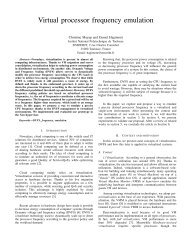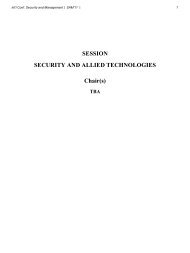SESSION NOVEL ALGORIHMS AND APPLICATIONS + ...
SESSION NOVEL ALGORIHMS AND APPLICATIONS + ...
SESSION NOVEL ALGORIHMS AND APPLICATIONS + ...
Create successful ePaper yourself
Turn your PDF publications into a flip-book with our unique Google optimized e-Paper software.
28 Int'l Conf. Foundations of Computer Science | FCS'11 |<br />
A 4 out of n Secret Sharing Scheme in Visual Cryptography without Expansion<br />
Ying-Yu Chen<br />
Department of Computer Science and Information<br />
Engineering, National Chi Nan University<br />
Puli, Nantou 54561, Taiwan, R.O.C.<br />
e-mail: s99321514@ncnu.edu.tw<br />
AbstractVisual cryptography (VC, for short) encrypts the<br />
secret image into n shares (transparency). We cannot see any<br />
information from any one share, and decrypt the original image<br />
by stacking all of the shares. Now, we extend it to the k out of n<br />
secret sharing scheme. (k, n) threshold secret sharing scheme<br />
encrypts as the same way and decrypts the original image by<br />
stacking at least k shares. If one stacks less than k shares, he (or<br />
she) cannot recognize the secret image. In this paper, we<br />
construct a new scheme for (4, n) threshold secret sharing<br />
encrypt in VC by using a method of combination and the size of<br />
the share is as small as the original image. That is, there is no<br />
expanded need while some of the previous scheme need.<br />
Keywords-visual cryptography; secret sharing scheme; security;<br />
share.<br />
I. INTRODUCTION<br />
Visual cryptography (VC, for short) and the (k,<br />
n)-threshold secret sharing scheme were proposed by<br />
Naor and Shamir in 1995 [9]. Visual cryptography<br />
means the secret image is turned into n shares that<br />
combined with black and white pixel, and the<br />
decrypting by stacking the shares together to reveal<br />
the secret image. So we can decrypt the secret image<br />
by human’s eye without using computer. The (k,<br />
n)-threshold secret sharing scheme means a dealer<br />
sends a share to each of the n users. In the condition<br />
of k is small or equal than n, the fewer than k users<br />
stack their shares together, they cannot see any<br />
information from the image. But at least k users stack<br />
their shares together, they will find out the secret from<br />
the image.<br />
In most of the VC scheme [2, 4, 7, 8, 9, 10, 12],<br />
the pixel of each share will expand. The more value of<br />
n is, the more value of the expansion will be.<br />
However, the size of the share is larger than the<br />
original image. In 1995, Naor and Shamir [9]<br />
proposed some (k, n)-threshold secret sharing in VC<br />
for three kinds of condition. First, some of their<br />
schemes are the efficient solutions for (2, n) and (3, n).<br />
Second, they propose a general k out of k scheme.<br />
_________________________________<br />
* Corresponding author.<br />
Justie Su-Tzu Juan *<br />
Department of Computer Science and Information<br />
Engineering, National Chi Nan University<br />
Puli, Nantou 54561, Taiwan, R.O.C.<br />
e-mail: jsjuan@ncnu.edu.tw<br />
Third, they propose a general k out of n scheme when<br />
k is small or equal than n. But the pixel of each share<br />
will expand in their later two methods. For<br />
convenience, the third method is called NS scheme in<br />
this paper.<br />
In 2008, Fang et al. propose a new algorithm<br />
(called FLL scheme in this paper) [6]. They solve the<br />
problem in expansion. In FLL scheme, the authors use<br />
Hilbert-curve [1] and two queues to present a VC<br />
scheme. The shares they generate are as small as the<br />
input image S, so the pixel of each share won’t<br />
expand. But since Fang et al. use Naor and Shamir’s<br />
scheme to design their scheme, the more number of<br />
the expansion in Naor and Shamir’s scheme is, the<br />
image we decrypted will be more unclear in FLL<br />
scheme.<br />
Another subject has been considered these years,<br />
progressive visual secret sharing (PVSS, for shout)<br />
scheme [3, 5]. In 2011, Hou et al. propose a new<br />
algorithm for (2, n) threshold PVSS scheme [3].<br />
In above researches, no matter the shares will be<br />
expansion or not, it cannot reveal the secret image by<br />
stacking less than k shares and it can reveal the secret<br />
image by stacking at least k shares for k ≥ 4. Because<br />
the expansion in the most of (4, n)-threshold secret<br />
sharing scheme in VC is quite large and the image we<br />
decrypted will be not clear in FLL scheme for (4,<br />
n)-threshold secret sharing scheme in VC. Hence, we<br />
propose a new scheme to improve it. We use the<br />
theory of combination to construct the scheme.<br />
Actually, our scheme is also a (4, n) threshold PVSS<br />
scheme. The detail of our scheme is presented on next<br />
section. Some experiment results are given in section<br />
, and the conclusion is stated in section .<br />
II. THE PROPOSED SCHEME<br />
We will show our (4, n)-threshold secret sharing<br />
scheme in VC as follows. For convenience, let









